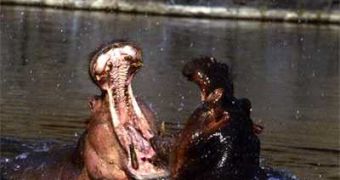1. The closest relatives of the hippopotamus are ...the whales and dolphins!
2-3 million years ago, there were numerous species of hippopotamus, including outside mainland Africa in Europe (UK included), Asia (plus Sri Lanka), and Madagascar.
Hippopotamus gorgops, which inhabited deeper waters than the current species, lived 120,000 years ago in the UK. 10,000 years ago, in Cyprus, Crete, Malta and Sicily lived dwarf species of hippopotamus. They were exterminated by humans. 1,000 years ago disappeared from Madagascar Hippopotamus lemerlei, a dwarf species, perhaps due to clime fluctuations and human hunting.
Only elephants are bigger than hippopotamuses: adult males can be 3 tonnes, and exceptionally 4.5 tonnes, heavy.
2. The hippopotamus can survive 5 minutes under water. The hippopotamus swims and dives. Even mating takes place in the water.
On 100 m (330 ft) of river, there are 33 individuals and on 100 m of lake shore there are 7 animals. Large groups gather during the dry season at the few remaining water pools.
3. The mouth can be opened at 150?, a record amongst all vertebrates. The muscles opening the mouth are well developed.
4. A dominant male holds 50-500 m (166-1,660 ft) of lake shore. Males fight to the death for territory with their huge tusks, 70 cm (2.3 ft long) and 3 kg (6.6 pounds) heavy. Because of the huge tusks and the opening of the mouth, a hippo bite can easily crush a rhino foot. (in fact, hippopotamuses kill more humans in Africa than any other wild beast).
A 50 cm of fat layer (90 kg or 200 pound per carcass) protects the vital inner organs during the fights. The dominated males poop towards the dominant male. Males mark their territories with feces spread by fluttering the tail while defecating (that's why the tail is more muscular in males).
Males are sexually mature at 6-13 years old, females at 7-15 years. The young suckle holding their breath, even on solid ground. If a new male takes the group, chasing away the former dominant male, he will kill all the young of the group, so that the females turn into heat and mate with him.
5. Hippos spend their time in the water to protect themselves against the tropical sun and for homeothermy (the temperature of the water is close to that of the body), and this way they waist less energy. Hippopotamuses sweat 3-5 more than a human. Their sweat is red!
But hippopotamuses feed outside the water during the night, up to 3.2 km (2 mi) outside the water, and even 10 km (6.2 mi) during the dry season. Even if so massive, they can reach 30 km (19 mi) per hour land, overrunning easily a human.
Hippopotamuses have 3 ft (10 ft) long stomachs and can ingest up to 100 kg (225 pounds) of food per night.
At an ideal density of 7.7 hippopotamuses per square km, these animals boost the biological production of the water. The dung spurs the algae and plant growth, translated to a lot of food for fish and aquatic antelopes. On fish, birds, turtles and crocodiles thrive.
Hippopotamuses are involved in cycles on the river edges. By grazing the grass, they favor the installation of trees. Because of the trees, hippopotamuses cannot find food and vanish; now elephants come, destroying the trees, the grass regrows and hippopotamuses reappear.
6. In the forests of western Africa lives the pygmy hippopotamus, a forest species less connected to water, the size of a large wild boar.

 14 DAY TRIAL //
14 DAY TRIAL //